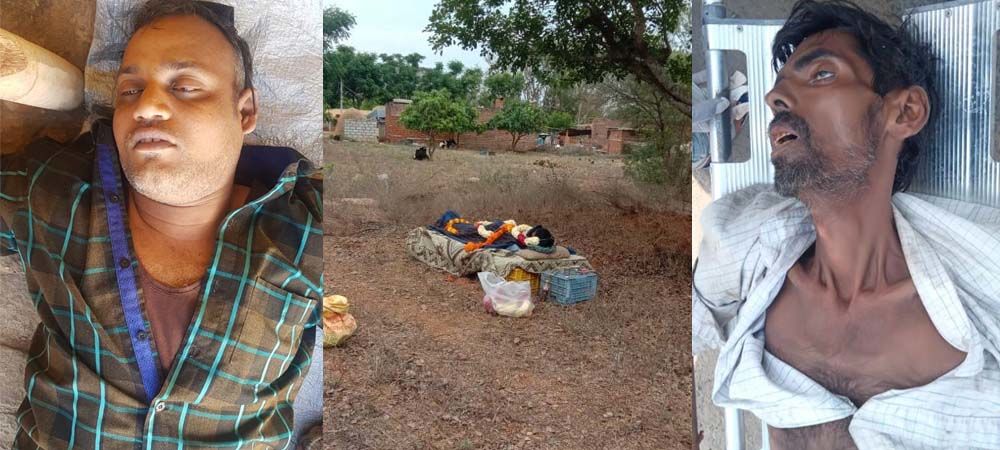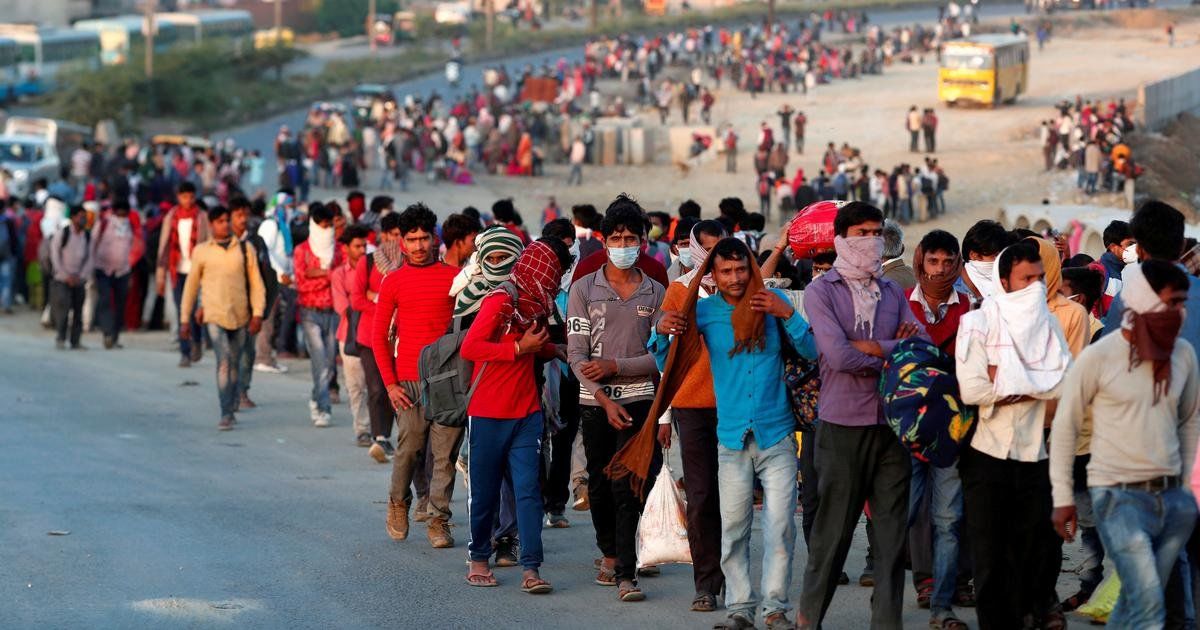Refugees in their own land, informal sector workers reduced to mere death toll statistics
Forty-five days past the declaration of the nationwide COVID19 lockdown, migrant workers continue to criss-cross the length and breadth of our vast country on foot


Sixteen migrant workers from Madhya Pradesh died on May 8 on the railway tracks in Aurangabad, Maharashtra, as a goods train ran over them while they fell asleep exhausted due to the long march to their homes 900 kilometres (km) away
Dhansingh Gond, Narvesh Singh Gond, Acchelal Singh, Brajesh Bhayadin, Dharmendra Singh Gond. These are just five names of the total 16 migrant workers from Madhya Pradesh, who died early in the morning on May 8 on the railway tracks in Aurangabad, Maharashtra, as a goods train ran over them while they fell asleep exhausted due to the long march to their homes 900 kilometres (km) away.
These dead labourers are now a part of the growing death toll of workers in the country, who have lost their lives during the pandemic, not due to COVID19, but other reasons of hunger, exhaustion, distress, accident, etc.
Based on the news reports, it is estimated that between March 25 and May 8, at least 370 people have died in the country during the nationwide lockdown, which started on March 25 and is expected to go on till at least May 18.

This comes to at least eight deaths every day in the lockdown period due to non-COVID19 reasons. Needless to say, this data is an under- representation of the magnitude of the humanitarian crisis in the country, as not all such deaths across the country are picked up by the media.
And, it is not just the adult male migrant workers getting killed while walking back home. Last month, a 12-year-old girl died after walking nearly 150 km from Telangana to her native Bijapur district in Chhattisgarh. The only child of her parents, she used to work in the chilli fields to support her parents’ income.
Another couple, Pramila and Krishna Sahu, which was cycling down on May 6 from Lucknow in Uttar Pradesh to its village over 800 kms away in Chhattisgarh, was hit by a speeding vehicle and died. Their two little children are now orphaned.
But, why are these migrant workers walking, or pedalling, hundreds of kilometres in the peak summer heat, risking their lives and those of their little children, too?
This is no Fit India challenge. This is the desperation of the migrant labour force of the country, which, since March 25, is stranded in cities, under the flyovers, on the highways, in make-shift tents, wanting to get back to their native villages. The majority of these poor people neither have wages, nor food on them.
On March 24, when Prime Minister Narendra Modi declared a nationwide lockdown, which came into force within the next four hours, there was no way for these migrant workers to return home at such short notice. All modes of passenger transport are shut across the country making it impossible for these migrant workers to return to their villages. The initial three-week lockdown has already been extended twice and is expected to go on till at least May 18.
It was only a month after the announcement of the nationwide lockdown, the Union Ministry of Home Affairs issued an order on April 29 allowing the movement of migrant workers with certain protocols, including a medical screening at source and destination; and home/institutional quarantine on arrival.
But, since then the matter of transportation of migrant workers to their home states has become a ping-pong match between the Centre and the state governments. The Centre claims it has cleared the decks for the movement of migrant labourers and is paying 85 per cent of the train fare cost (the rest 15 per cent to be borne by the state governments). But, the state are refuting this claim of the Centre.

Meanwhile, several state governments are themselves not very keen to have their people, the migrant workers, back. They fear the workers may return with the coronavirus and spread it in the ‘green’ zones. There are reports of migrant workers in Bihar facing a social boycott and are not welcome back home.
In Odisha, the Orissa High Court went a step ahead and ordered on May 7 that the state government should ensure all the migrants who are in queue to come to the state should be tested negative of COVID19 before boarding the conveyance. However, the very next day, the Supreme Court stayed this order of the high court as the Centre said the order was “unworkable” and passed without consultation.
Meanwhile, in the southern state Karnataka, where a large number of migrant labourers are stranded in Bengaluru and wish to return to their home states, the chief minister BS Yediyurappa held a meeting with the builders on May 5 to “discuss issues related to migrant labourers”. The builders informed the chief minister “the labourers were given all essential facilities and construction activities have already started”, and asked for directions “to convince the labourers to refrain from returning to their home states”.
So, in order to boost the construction sector, the Karnataka government cancelled the trains it had booked to take migrant labourers home. It is only after sharp criticism from several quarters that the state government reversed its order and trains are once again pressed into service. The Indian Railways is running Shramik special trains from various cities to transport the stranded workers back home.
Seeing the manner in which migrant workers are being treated during a crisis — either viewed as coronavirus carriers, or boosters of the state economies — one would expect a further strengthening of the labour laws in the country to provide teeth to legal provisions protecting the interest of the poor workers.
But exactly the opposite is unfolding in the country. At least four state governments — Uttar Pradesh, Madhya Pradesh, Rajasthan and Gujarat — have pushed changes in their labour laws by way of ordinances or executive orders to promote industrial and economic activities. Some of these amendments would require approval from the central government to come into effect.
Uttar Pradesh, as per news reports, has cleared an ordinance exempting businesses from the purview of most labour law provisions for the next three years. But, labour laws related to bonded labour, deployment of women and children, and timely payment of salaries are not relaxed.

In Madhya Pradesh, the state government has allowed an extension of daily working hours to 12 hours and has also exempted employers from some obligations under various labour laws, such as Madhya Pradesh Industrial Relations Act and Industrial Disputes Act, as well as Contract Labour Act for 1,000 days, allowing employers to hire and fire workers “at their convenience”. This is not all. The state has also exempted new factories under the Factories Act, 1948 from inspection from the Labour Department and permitted the flexibility to conduct third party inspections at will.
Rajasthan has also raised the working hours from 8 hours per day to 12 hours per day. The state government has also amended the Industrial Disputes Act to increase the threshold for lay-offs and retrenchment to 300 from 100 earlier. Punjab, Himachal Pradesh, and Gujarat have also amended their factories Acts to increase the work time to 12 hours every day and 72 hours every week, compared to the earlier 8 hours every day and 48 hours every week.
While the states resort to the tweaking of labour laws to boost their economies, the country faced three industrial accidents on a single day, as factories tried reopening post the lockdown.

On the pre-dawn of May 7, a gas leak from a factory in Visakhapatnam in Andhra Pradesh killed at least 12 people and several hundred were hospitalised. The same morning, another seven workers of a paper mill in Raigarh, Chhattisgarh were hospitalised after they inhaled poisonous gas at the factory. The third industrial accident of the day took place in Tamil Nadu where eight workers sustained burn injuries in a boiler blast at NLC India Limited’s thermal power station in Neyveli.
In such a scenario, should we be relaxing our labour laws and factories regulations? Or, should we further strengthen the legislations to protect the livelihoods and lives of workers, especially in the informal sector? The answer shouldn’t be very difficult.

